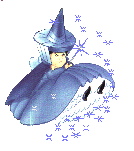 The Three Fairies!
The Three Fairies!

 Flora, Fauna and Merriweather. Sleeping Beauty is not the best of the Disney fairy-tale knock-offs, but damn it, these are good fairies. And it's worth noting (assuming that one has nothing better to do) that the general physical types of the three Disney fairies map on fairly well to the physical types of our Girls with Glasses. I can never keep straight which is Flora and which is Fauna, but be advised, Merryweather (the plump little fairy in blue) is DEFINITELY Faye.
Flora, Fauna and Merriweather. Sleeping Beauty is not the best of the Disney fairy-tale knock-offs, but damn it, these are good fairies. And it's worth noting (assuming that one has nothing better to do) that the general physical types of the three Disney fairies map on fairly well to the physical types of our Girls with Glasses. I can never keep straight which is Flora and which is Fauna, but be advised, Merryweather (the plump little fairy in blue) is DEFINITELY Faye.
 Incidentally, the Disney fairies give us a nice way to link back to our Weird Sisters. In the original Grimm tale, there were not 3 good fairies and 1 evil one (Maleficent), but rather 13 fairies altogether. The king and queen stiff one of the fairies out of an invite to the infant-princess' christening (they don't have enough gold plates--don't you hate when that happens?), and she in turn casts an evil spell, which the royals richly deserve.
Incidentally, the Disney fairies give us a nice way to link back to our Weird Sisters. In the original Grimm tale, there were not 3 good fairies and 1 evil one (Maleficent), but rather 13 fairies altogether. The king and queen stiff one of the fairies out of an invite to the infant-princess' christening (they don't have enough gold plates--don't you hate when that happens?), and she in turn casts an evil spell, which the royals richly deserve.
 In switching to 3 fairies, the good folks at Disney seem to be picking up an alternate folkloric pattern, one which shows up throughout the Grimm canon. The most notable example? The tale of "The Three Spinning Fairies," which features (ta da!) three spinning fairies (that is, they are fairies who spin thread, not who themselves spin). It doesn't take a master mind to connect these folkloric figures to the Greek fates, Lachesis, Clotho, and Atropos, who spin, measure, and cut the thread of life. It's goddesses of destiny again, folks!
In switching to 3 fairies, the good folks at Disney seem to be picking up an alternate folkloric pattern, one which shows up throughout the Grimm canon. The most notable example? The tale of "The Three Spinning Fairies," which features (ta da!) three spinning fairies (that is, they are fairies who spin thread, not who themselves spin). It doesn't take a master mind to connect these folkloric figures to the Greek fates, Lachesis, Clotho, and Atropos, who spin, measure, and cut the thread of life. It's goddesses of destiny again, folks!
And throughout western culture, goddess/witch figures almost always come in threes. For example, there's the Greek Hecate, the goddess of magic and witchcraft (said to be the mother of Circe and Medea) who manifests herself in three aspects: the goddess of fertility and plenty, the goddess of the moon, and the queen of the night, ghosts and shades. And she's part of a lunar trinity as well--the three moon goddesses Hecate, Selene and Diana.
And what about the morrigan--the Irish goddess of war--who manifests herself in three aspects (maiden, matron and crone), mimicking the phases of the moon? And of course, who wouldn't know to connect her to one of her descendent figures, Morgan le Fey, a composite figure from later Arthurian lore. Morgan (half-sister to Arthur) both opposes the king and tries to heal him; she hates him and takes him as her incestuous lover.
I could go on and on. But that's enough for now.